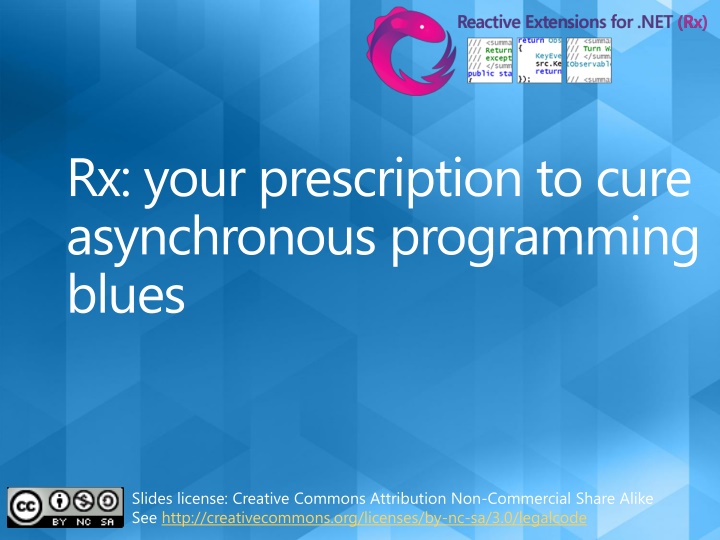
How to Cure Asynchronous Programming Blues
Learn how to cure your asynchronous programming blues with Rx, a library for composing asynchronous and event-based programs using observable collections. Explore essential interfaces, dualization concepts, and more in this insightful guide.
Download Presentation

Please find below an Image/Link to download the presentation.
The content on the website is provided AS IS for your information and personal use only. It may not be sold, licensed, or shared on other websites without obtaining consent from the author. If you encounter any issues during the download, it is possible that the publisher has removed the file from their server.
You are allowed to download the files provided on this website for personal or commercial use, subject to the condition that they are used lawfully. All files are the property of their respective owners.
The content on the website is provided AS IS for your information and personal use only. It may not be sold, licensed, or shared on other websites without obtaining consent from the author.
E N D
Presentation Transcript
Rx: your prescription to cure asynchronous programming blues Slides license: Creative Commons Attribution Non-Commercial Share Alike See http://creativecommons.org/licenses/by-nc-sa/3.0/legalcode
Mission statement (? ?)(?) = ?(?(?)) Too hard today Rx is a library for Rx is a library for composing asynchronous and event asynchronous and event- -based using using observable collections observable collections. . composing based programs programs Queries? LINQ? Download at MSDN DevLabs .NET 2.0, .NET 4.0, Silverlight JavaScript, more ?
Essential Interfaces Enumerables a pull-based world interface IEnumerable<out T> { IEnumerator<T> GetEnumerator(); } C# 4.0 covariance interface IEnumerator<out T> : IDisposable { bool MoveNext(); T Current { get; } void Reset(); } You could get stuck
Essential Interfaces Enumerables a pull-based world (Waiting to move next) C# 4.0 covariance moving on You could get stuck
Mathematical duality Because the Dutch are (said to be) cheap Electricity: inductor and capacitor A diagram of several inductors, side by side, both leads of each connected to the same wires http://upload.wikimedia.org/wikipedia/commons/thumb/7/75/Capacitors_in_series.svg/220px-Capacitors_in_series.svg.png Logic: De Morgan s Law ? ? ? ? ? ? ? ? Programming?
Whats the dual of IEnumerable? The recipe to dualization http://en.wikipedia.org/wiki/Dual_(category_theory) Reversing arrows Reversing arrows Input becomes output and vice versa Input becomes output and vice versa Making a U-turn in synchrony
Whats the dual of IEnumerable? Step 1 Simpler and more explicit interface IEnumerable<T> { IEnumerator<T> GetEnumerator(); } GetEnumerator(void); interface IEnumerator<T> : IDisposable { bool MoveNext(); T Current { get; } void Reset(); } MoveNext(void);throws Exception; GetCurrent(void); C# didn t borrow Java checked exceptions
Whats the dual of IEnumerable? Step 1 Simpler and more explicit interface IEnumerable<T> { ( & IEnumerator<T> GetEnumerator(void); We really got an enumerator ) } and a disposable interface IEnumerator<T> : { bool MoveNext(void) throws Exception; T GetCurrent(void); } IDisposable
Whats the dual of IEnumerable? Step 2 Swap input and output interface { (IDisposable & } IEnumerableDual<T> IEnumerable<T> Set ); IEnumerator<T> ) GetEnumerator( void Will only dualize the synchrony aspect interface IEnumerator<T> { bool MoveNext(void) throws Exception; T GetCurrent(void); }
Whats the dual of IEnumerable? Step 2 Swap input and output interface IEnumerableDual<T> { IDisposable SetEnumerator(IEnumerator<T> x); } This is an output too interface IEnumerator<T> { bool MoveNext(void) throws Exception; T GetCurrent(void); }
Whats the dual of IEnumerable? Step 2 Swap input and output interface IEnumerableDual<T> { IDisposable SetEnumerator(IEnumerator<T> x); } interface IEnumerator<T> { (bool | Exception) MoveNext(void); T GetCurrent(void); } Discrete domain with true and false
Whats the dual of IEnumerable? Step 2 Swap input and output interface IEnumerableDual<T> { IDisposable SetEnumerator(IEnumerator<T> x); } interface IEnumerator<T> { (true | false | Exception) MoveNext(void); T GetCurrent(void); } If you got true, you really got a T T
Whats the dual of IEnumerable? Step 2 Swap input and output interface IEnumerableDual<T> { IDisposable SetEnumerator(IEnumerator<T> x); } interface IEnumerator<T> { (T | false | Exception) MoveNext(void); } void If you got false, you really got void
Whats the dual of IEnumerable? Step 2 Swap input and output interface IEnumerableDual<T> { IDisposable SetEnumerator( } IEnumeratorDual>); IEnumerator<T> x); IEnumeratorDual<T> IEnumerator<T> interface { (T | void | Exception) MoveNext(void Got ); } But C# doesn t have discriminated unions Let s splat this into three methods instead!
Whats the dual of IEnumerable? Step 2 Swap input and output interface IEnumerableDual<T> { IDisposable SetEnumerator(IEnumeratorDual<T>); } interface IEnumeratorDual<T> { void GotT(T value); void GotException(Exception ex); void GotNothing(void); }
Whats the dual of IEnumerable? Step 3 Consult the Gang of Four interface IObservable<T> { IDisposable SetObserver(IObserver<T> observer); } interface IObserver<T> { void GotT(T value); void GotException(Exception ex); void GotNothing(); } Source: http://amazon.com
Whats the dual of IEnumerable? Step 4 Variance annotations interface IObservable<out T> { IDisposable SetObserver(IObserver<T> observer); } Used to detachthe observer Do you really know C# 4.0? interface IObserver<in T> { void GotT(T value); void GotException(Exception ex); void GotNothing(); }
Whats the dual of IEnumerable? Step 5 Color the bikeshed (*) interface IObservable<out T> { IDisposable Subscribe(IObserver<T> observer); } interface IObserver<in T> { void OnNext(T value); void OnError(Exception ex); void OnCompleted(); } (*) Visit http://en.wikipedia.org/wiki/Color_of_the_bikeshed
Essential Interfaces Observables a push-based world interface IObservable<out T> { IDisposable Subscribe(IObserver<T> observer); } C# 4.0 contravariance interface IObserver<in T> { void OnNext(T value); void OnError(Exception ex); void OnCompleted(); } You could get flooded
Essential Interfaces Summary push versus pull Application Interactive MoveNext Got next? Reactive OnNext Have next! IObservable<T> IObserver<T> IEnumerable<T> IEnumerator<T> Environment
demo Essential Interfaces
Getting Your Observables Primitive constructors OnCompleted new int[0] Observable.Empty .Empty< <int int>() >() OnNext new[] { 42 } Observable.Return .Return(42) (42) OnError Throwing iterator Observable.Throw .Throw< <int int>(ex) >(ex) Observable.Never .Never< <int int>() >() Iterator that got stuck Notion of time
Getting Your Observables Observer (and enumerator) grammar OnNext* [ OnError | OnCompleted ] OnNext(1) OnNext(2) OnNext(0) Observable.Range .Range(0, 3) (0, 3) yield 1 yield 2 yield 0 Enumerable.Range .Range(0, 3) (0, 3)
Getting Your Observables Generator functions A variant with time notion exists (GenerateWithTime) Hypothetical anonymous iterator syntax in C# o = Observable.Generate( 0, i => i < 10, i => i + 1, i => i * i ); e = new IEnumerable<int> { for (int i = 0; i < 10; i++) yield return i * i; }; Synchronous Asynchronous o.Subscribe(x => { Console.WriteLine(x); }); foreach (var x in e) { Console.WriteLine(x); }
Getting Your Observables Create our most generic creation operator IObservable<int> o = Observable.Create<int>(observer => { // Assume we introduce concurrency (see later) observer.OnNext(42); observer.OnCompleted(); }); IDisposable subscription = o.Subscribe( onNext: x => { Console.WriteLine("Next: " + x); }, onError: ex => { Console.WriteLine("Oops: " + ex); }, onCompleted: () => { Console.WriteLine("Done"); } ); C# doesn t have anonymous interface implementation, so we provide various extension methods that take lambdas. C# 4.0 named parameter syntax
Getting Your Observables Create our most generic creation operator IObservable<int> o = Observable.Create<int>(observer => { // Assume we introduce concurrency (see later) observer.OnNext(42); observer.OnCompleted(); }); IDisposable subscription = o.Subscribe( onNext: x => { Console.WriteLine("Next: " + x); }, onError: ex => { Console.WriteLine("Oops: " + ex); }, onCompleted: () => { Console.WriteLine("Done"); } ); Thread.Sleep(30000); // Main thread is blocked F10
Getting Your Observables Create our most generic creation operator IObservable<int> o = Observable.Create<int>(observer => { // Assume we introduce concurrency (see later) observer.OnNext(42); observer.OnCompleted(); }); IDisposable subscription = o.Subscribe( onNext: x => { Console.WriteLine("Next: " + x); }, onError: ex => { Console.WriteLine("Oops: " + ex); }, onCompleted: () => { Console.WriteLine("Done"); } ); Thread.Sleep(30000); // Main thread is blocked F10
Getting Your Observables Create our most generic creation operator IObservable<int> o = Observable.Create<int>(observer => { // Assume we introduce concurrency (see later) observer.OnNext(42); observer.OnCompleted(); }); IDisposable subscription = o.Subscribe( onNext: x => { Console.WriteLine("Next: " + x); }, onError: ex => { Console.WriteLine("Oops: " + ex); }, onCompleted: () => { Console.WriteLine("Done"); } ); Thread.Sleep(30000); // Main thread is blocked F5
Getting Your Observables Create our most generic creation operator IObservable<int> o = Observable.Create<int>(observer => { // Assume we introduce concurrency (see later) observer.OnNext(42); observer.OnCompleted(); }); Breakpoint got hit IDisposable subscription = o.Subscribe( onNext: x => { Console.WriteLine("Next: " + x); }, onError: ex => { Console.WriteLine("Oops: " + ex); }, onCompleted: () => { Console.WriteLine("Done"); } ); Thread.Sleep(30000); // Main thread is blocked
demo Getting Your Observables
Bridging Rx with the World Why .NET events aren t first-class How to pass around? Hidden data source form1.MouseMove .MouseMove += (sender, args args) => { if ( (args.Location.X == args.Location.Y) ) // I d like to raise another event }; Lack of composition form1.MouseMove - -= = /* what goes here? */ Resource maintenance?
Bridging Rx with the World but observables sequences are! Objects can be passed Source of Point values IObservable IObservable< <Point Observable.FromEvent Observable.FromEvent(frm, "MouseMove"); var filtered = mouseMoves .Where( .Where(pos => pos.X == pos.Y) ); Point> > mouseMoves = Can define operators var subscription = filtered.Subscribe( ); subscription.Dispose .Dispose() (); Resource maintenance!
Bridging Rx with the World Asynchronous methods are a pain Exceptions? Hidden data source FileStream fs = File.OpenRead("data.txt"); byte[] bs = new byte[1024]; fs.BeginRead(bs, 0, bs.Length, new AsyncCallback(iar => { int bytesRead = fs.EndRead(iar); // Do something with bs[0..bytesRead-1] }), null ); State? Really a method pair Cancel? Lack of composition Synchronous completion?
Bridging Rx with the World but observables are cuter! FileStream fs = File.OpenRead("data.txt"); Func<byte[], int, int, IObservable<int>> read = Observable.FromAsyncPattern<byte[], int, int, int>( fs.BeginRead, fs.EndRead); byte[] bs = new byte[1024]; read(bs, 0, bs.Length).Subscribe(bytesRead => { // Do something with bs[0..bytesRead-1] }); Tip: a nicer wrapper can easily be made using various operators
Bridging Rx with the World The grand message We don t replace existing asynchrony: .NET events have their use the async method pattern is fine too other sources like SSIS, PowerShell, WMI, etc. but we unify those worlds introduce compositionality provide generic operators hence we build bridges!
Bridging Rx with the World Terminology: hot versus cold observables Cold observables var xs = Observable.Return(42); Triggered by subscription xs.Subscribe(Console.WriteLine); // Prints 42 xs.Subscribe(Console.WriteLine); // Prints 42 again Hot observables var mme = Observable.FromEvent<MouseEventArgs> (from, "MouseMove"); Mouse events going before subscription mme.Subscribe(Console.WriteLine);
demo Bridging Rx with the World
Composition and Querying Concurrency and synchronization What does asynchronous mean? Greek: a-syn = not with (independent from each other) chronos = time Two or more parties work at their own pace Need to introduce concurrency Notion of IScheduler var xs = Observable.Return(42, Scheduler.ThreadPool); xs.Subscribe(Console.WriteLine); Parameterization of operators Will run on the source s scheduler
Composition and Querying Concurrency and synchronization Does duality apply? Convert between both worlds // Introduces concurrency to enumerate and signal var xs = Enumerable.Range(0, 10).ToObservable(); // Removes concurrency by observing and yielding var ys = Observable.Range(0, 10).ToEnumerable(); Time-centric reactive operators: source1 source2 source1.Amb( Race! .Amb(source2) )
Composition and Querying Concurrency and synchronization How to synchronize? var xs = Observable.Return(42, Scheduler.ThreadPool); xs.Subscribe(x => lbl.Text = "Answer = " + x); IScheduler WPF dispatcher WinForms control SynchronizationContext Compositionality to the rescue! xs.ObserveOn(frm) .Subscribe(x => lbl.Text = "Answer = " + x);
Composition and Querying Standard Query Operators Observables are sources of data Data is sent to you (push based) Extra (optional) notion of time Hence we can query over them // Producing an IObservable<Point> using Select var mme = from mm in Observable.FromEvent<MouseEventArgs>( form, MouseMove ) select mm.EventArgs.Location; // Filtering for the first bisector using Where var res = from mm in mme where mm.X == mm.Y select mm;
Composition and Querying Putting the pieces together Asynchronous request $$$ IObservable<string> TextChanged Dictionary web service React Reaction Reactive Reactor IObservable<DictionaryWord[]> Data binding on UI thread
Composition and Querying SelectMany composition at its best // IObservable<string> from TextChanged events var changed = Observable.FromEvent<EventArgs>(txt, "TextChanged"); var input = (from text in changed select ((TextBox)text.Sender).Text); .DistinctUntilChanged() .Throttle(TimeSpan.FromSeconds(1)); // Bridge with the dictionary web service var svc = new DictServiceSoapClient(); var lookup = Observable.FromAsyncPattern<string, DictionaryWord[]> (svc.BeginLookup, svc.EndLookup); // Compose both sources using SelectMany var res = from term in input from words in lookup(term) select words; input.SelectMany(term => lookup(term))
demo Composition and Querying
Composition and Querying Asynchronous programming is hard React Reactive | R| Re| Rea| Reac| React| React| Reacti| Reactiv| Reactive| input input Reactive Reaction Reactive Reactor Service call 1 Service call 2 UI data binding Reactive Reaction Reactive Reactor Source: http://scrapetv.com
Composition and Querying Fixing out of order arrival issues React Reactive | R| Re| Rea| Reac| React| React| Reacti| Reactiv| Reactive| input input Until Cancel call 1 Reactive Service call 1 Take Service call 2 UI data binding Reactive Reaction Reactive Reactor
Composition and Querying Applying the TakeUntil fix // IObservable<string> from TextChanged events var changed = Observable.FromEvent<EventArgs>(txt, "TextChanged"); var input = (from text in changed select ((TextBox)text.Sender).Text); .DistinctUntilChanged() .Throttle(TimeSpan.FromSeconds(1)); // Bridge with the dictionary web service var svc = new DictServiceSoapClient(); var lookup = Observable.FromAsyncPattern<string, DictionaryWord[]> (svc.BeginLookup, svc.EndLookup); Very local fix // Compose both sources using SelectMany var res = from term in input from words in lookup(term).TakeUntil(input) select words; select lookup(term)) .Switch(); // Alternative approach for composition using: // IObservable<T> Switch<T>(IObservable<IObservable<T>> sources) var res = (from term in input Hops from source to source
demo Fixing asynchronous issues
Rx for JavaScript (RxJS) Parity with Rx for .NET Set of operators Taming asynchronous JS JavaScript-specific bindings jQuery ExtJS Dojo Prototype YUI3 MooTools Bing APIs
Rx for JavaScript (RxJS) $("#input").ToObservable("keyUp") .Throttle(250) .Select(function(ev) { return query($(ev.target).text()); }) .Switch() .Select(function(result) { return formatAsHtml(result); }) .Subscribe( function(results) { $("#results").html(results); }, function(error) { $("#results").html("Error: " + error); });





